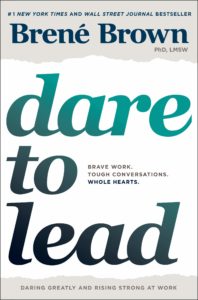Brené Brown is a researcher of shame and vulnerability, and while that might seem like an odd fit for a book about leadership in the workplace, Brown brings her usual energy and winsome earnestness to a compelling argument that vulnerability is indeed at the heart of all courageous leadership. Dare to Lead promotes strong leadership through soft hearts, which is, frankly, exactly the leadership book we need in 2020. Topics include how to be vulnerable as a leader and why you should, how to lead difficult conversations and elicit vulnerability from your team to get to the heart of issues, and how to avoid common pitfalls that make people “armor up” and fall into unhealthy patterns.
Like many, I first came to Brown’s work through her TED Talks on shame and vulnerability. If you’re wondering whether you’ll like this book, those talks are fabulous, and will let you preview some of the book’s underlying themes. The energy she brings to her talks practically leaps off the page with a written voice that mirrors her lecturing voice almost exactly. Brown is engaging and insightful in a way that feels earnest and open, but never feels cloying or aggressive. She’s not asking you to Lean In; she’s asking you to bring your “whole heart” to the table. And she’s got practical, data-driven reasons why you should.
The book claims to be a quick read, one which could be devoured “cover-to-cover in one flight”. And by the numbers and tone, that should be true. But I confess it took me a considerable amount of time to get through it, largely because some off-handed remark would literally completely change my worldview and I would have to put the book down to reflect on it. For example “resentment is almost always related to a lack of boundaries” was a half-sentence that was not even the main point of that sentence, much less that section, but it was a profound enough point that I had to step away. And these moments happened so frequently that the book was actually pretty slow to digest for me. So while I think this could be a breezy read, I also don’t think that’s the most product way to consume it.
The content itself is a nice balance of theoretical research and actionable takeaways. Brown has done the research, collected the data, and interpreted its results—then gone a step farther into translating those into actionable takeaways. This is Brown’s fifth book, and like most researchers, her work has built on itself cumulatively for years. Though Brown repeats extended sections from her previous books, she does a good job of highlighting how this work builds upon and extends the previous work. It didn’t feel overly repetitive for me, but I also haven’t read the entirety of her catalog.
It’s rare for me to say that a book has changed my life, but this book has shifted my approach—not just to leadership, but to communication as a whole—so fundamentally that it would be remiss of me to undersell its impact. But that said, due to the subject matter, this book rewards introspection and reflection even more than most self-help books, and you get out of it what you put in. Brown asks you to dive into uncomfortable places with yourself and with others, and while the rewards are great, the process is unapologetically brutal. But as she says, courage requires vulnerability, and “who we are is how we lead.”


